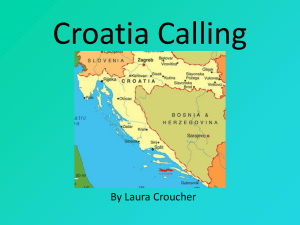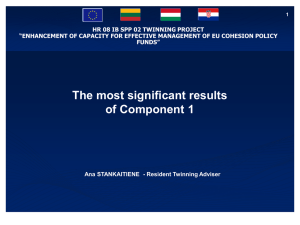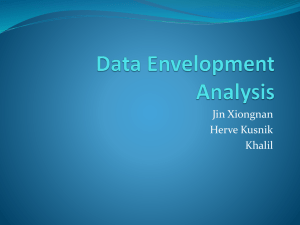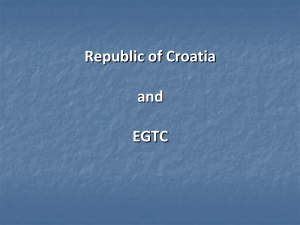Efficiency of public expenditure on education in Croatia
advertisement
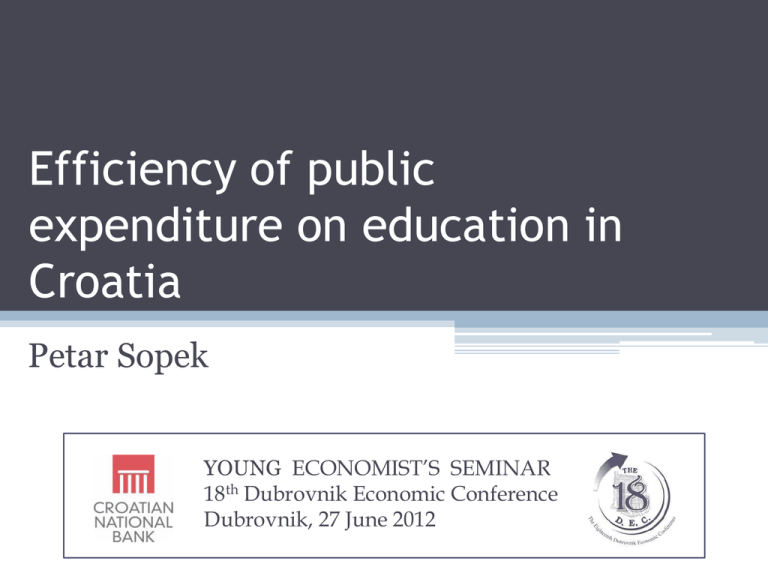
Efficiency of public expenditure on education in Croatia Petar Sopek YOUNG ECONOMIST’S SEMINAR 18th Dubrovnik Economic Conference Dubrovnik, 27 June 2012 Content • Efficiency (and effectiveness) • Educational indicators • FDH and DEA framework • Analysis of efficiency of public spending on education • Possible sources of inefficiency • Conclusions and recommendations Efficiency (and effectiveness) • Efficiency - the ratio between used input and produced output ▫ Technical and allocative efficiency ▫ Example: Performance of pupils or students of a certain age • Effectiveness - the input or the output to the final objectives to be achieved, that is the outcome ▫ Example: Educational qualification of the working-age population Source: Mandl, Dierx and Ilzkovitz Educational indicators (1) Public expenditure on education (% of GDP) • Average public expenditure on education (all countries) - 5% of GDP • Total public expenditure on education in Croatia in 2007 – 4% of GDP • Expenditure on pre-primary and primary levels of education about 59% of total expenditure on education (other observed countries - 37% in average) Does not take into account student population, a country’s standard of living etc. Source: Eurostat Educational indicators (2) Public expenditure on public educational institutions per pupil/student in thousand EUR PPS • Croatia has relatively low expenditure on public educational institutions, about 40% lower than the average of observed countries. • Majority of EU new member states spend even less than Croatia. Public expenditure on educational institutions is positively correlated with country standard. Source: Eurostat Educational indicators (3) Students in public institutions as a percentage of all students • Croatia has 4th highest proportion of students in public institutions, about 16 percentage points higher than the EU-27 average. • Primary and secondary private educational sector underdeveloped in Croatia? -> Implication: Public sector has to provide more resources than it would have to if there were a more developed private sector! Private expenditure on education in Croatia is mainly targeted to the pre-primary and tertiary education Source: Eurostat Educational indicators (4) PISA 2009 scores in mathematics, reading and science • Slovakia, Liechtenstein, Luxembourg and Japan, with lower public expenditure on education proportions of GDP than Croatia, recorded better average PISA scores in 2009. • The main hypothesis: Croatia has faced with inefficiency in public spending on education Performance of Croatian pupils: Science (486), Reading (476) Mathematics (460) Source: OECD FDH and DEA framework (1) Definitions • Free Disposable Hull (FDH) and Data Envelopment Analysis (DEA) are non-parametric techniques for input-output (technical) efficiency measurement. ▫ Free Disposable Hull (FDH) of S is the smallest free disposable set containing S. ▫ Convex Free Disposable Hull (CFDH) of S is the smallest convex free disposable set containing S. • Formally: - (p+q)-dimensional zero vector with k-th component equal to 1 • Borders of defined sets are called the efficiency frontiers. FDH and DEA framework (2) Conditions • FDH satisfies the following two conditions: 1. Every element from the observations set S belongs to the constructed production set 2. Every other unobserved pair of vectors that is weakly dominated in inputs and/or in outputs by some observation from S also belongs to the constructed production set • DEA additionally satisfies the following condition: 3. Every unobserved pair of vectors that is a convex combination of observation from the sample S induced by condition 1. and 2. also belongs to the constructed production set. • For each set of n actually observed production plans from a joint inputoutput space (S), the following condition is satisfied: FDH and DEA framework (3) Efficiency and frontiers • All points lying on the frontier are considered fully efficient, while points below the frontier are technically inefficient. • Inefficiency can be measured in two different ways: 1. Vertical distance from any point to the frontier measures the degree of output inefficiency or the output level that could have been achieved if all input was applied in an efficient way. This means that the same input allocated differently may produce higher output. 2. Horizontal distance from any point to the frontier measures the degree of input inefficiency or the input level that was wasted by inefficient allocation. • If there are no such decision making units (DMU) that may be considered more efficient than the i-th DMU, then unit input and output efficiency score is to be assigned to the i-th DMU. In this case, i-th DMU is lying on the frontier. • Otherwise, the decision unit is inefficient and placed inside the frontier. FDH and DEA framework (4) Efficiency determination - FDH • For i-th DMU in FDH model, all production plans that are more efficient are to be selected, i.e. the ones that produce more of each output with less of each input. • If there are no such DMUs that may be considered more efficient than the ith DMU, then i-th DMU has assigned unit input and output efficiency score. • If DMU i is not efficient, its FDH input efficiency score is equal to: - m production plans that are more efficient than production plan i • FDH output efficiency score is calculated in a similar way and is equal to: FDH and DEA framework (5) Efficiency determination - DEA • For some i-th DMU in DEA model, yi is the output column vector and xi is the column vector of the inputs. • There has to be defined X as the p×n input matrix and Y as the q×n output matrix. • DEA model is specified with the following mathematical programming problems: Input-oriented Output-oriented where: λ - n-dimensional vector of constants Іn - n-dimensional vector of ones Analysis of efficiency (1) Public expenditure on education (% GDP) and average PISA score • Input efficiency: Croatia might be able to achieve the same level of performance using only 47.2 percent of GDP expenditure on education it was using; A waste of input resources of around 53.8 percent. • Output efficiency: Croatia reached 89.5% (FDH) and 88.9% (DEA) of efficient PISA score; Unused output of 10.5% in FDH, i.e. 11.1% in DEA. Croatian rankings: 9th in FDH input 8th in DEA input 29th in FDH and DEA output Source: author based on Eurostat and OECD Analysis of efficiency (2) Public expenditure on education (per stud., EUR PPS) and PISA score • Input efficiency: Croatian efficiency score is around 0.815 in FDH and 0.541 in DEA, which means that a waste of input resources amounts to 18.5% and 45.9% respectively. • Output efficiency: Croatia reached 92.3% (FDH) and 91.8% (DEA) of efficient PISA score; Unused output of 7.7% in FDH, i.e. 8.2% in DEA. Croatian rankings: 12th in FDH input 14th in DEA input 22nd in FDH output 21st in DEA output Source: author based on Eurostat and OECD Analysis of efficiency (3) Public expenditure on education (per stud., EUR PPS) and PISA score • Relatively clear logarithmic relationship between expenditure on public educational institutions per pupil/student and performances in PISA tests. • Over one third of students’ performance can be explained with the level of public education funding. • Croatia is slightly inefficient, since the Croatian average PISA score is below the expected value for the amount of public expenditure on education. Source: author based on Eurostat and OECD Deviations from the estimated value resulted from unobserved influence of nonfinancial variables or the allocative (in)efficiency. Sources of inefficiency (1) Demographic and staff trends • Number of pupils and students has decreased by 10% since 2000. • Number of teaching staff has increased by 21% since 2000. • There has been an increase in the number of available schools of 2.5%. In 2000/2001: 217 pupils/students per school 17 teachers per school In 2009/2010: 190 pupils/students per school 20 teachers per school Source: author based on Croatian Bureau of Statistics Sources of inefficiency (2) Teachers per 100 pupils/students • Croatia had relatively high average number of teachers per 100 students of 9.2, about 1.2 more than the average of the observed European countries, USA and Japan. Source: Eurostat; author's calculation Sources of inefficiency (3) Excess of teaching staff • In Croatia there might be an excess of teaching force of 4,942 teachers. • Possible solution is to increase teaching hours, since teachers with a fulltime position are required to teach 16-22 hours per week. • Future demographic trends imply significant potential for savings, if the number of teachers and overall education spending can be reduced in line. Teachers per 100 students (2008) Pre-primary (ISCED 0) Basic (ISCED 1-2) Secondary (ISCED 3) Tertiary (ISCED 5-6) TOTAL Average of observed countries* 8.57 8.86 8.88 7.59 8.07 Croatia 7.32 7.70 12.96 9.67 9.22 Source: Eurostat; Croatian Bureau of Statistics; author's calculation Difference (Croatia Average) -1.26 -1.16 4.08 2.08 1.15 Number of pupils/students in Croatia (2009/10) 99,317 361,052 180,582 145,263 786,214 Teachers and teaching staff discrepancies -1,247 -4,195 7,367 3,017 4,942 Sources of inefficiency (4) General observations on salaries and quality of teachers • Smaller groups are usually more efficient than the large ones. • Higher teachers’ salaries, but not smaller class sizes, are associated with better student performance. • Raising teacher quality is a more effective route to improved student outcomes than creating smaller classes. • Salaries are set centrally for all teachers in Croatia, without any consideration of demand and supply in different regions and/or teaching subjects. • Salary levels at different career points are problematic in Croatia, since the increases are mainly driven by working experience and not necessarily quality. • Improvement of mechanisms of teacher assessment to bring them up to the level common in the private sector may result in high-quality teachers being attracted and motivated. Sources of inefficiency (5) General observations at the tertiary level • Average time for completion of a four-year program was 6.7 years. • Only about a third of students did complete, implying a two-thirds dropout rate. • Students that pay fees generally complete at higher rates, in a shorter time period and with better grades. • Student subsidies are numerous and considerable in their financial volume, but they are directed only to the maintenance or the occasional enlargement of the number of higher educated citizens. • Public subsidies to education mostly benefit households with higher incomes, since most scholarships and rewards go to students with better academic achievements, who tend to come from families in the top-income quintile that can spend more money to support. Conclusion • Croatian efficiency scores are way below 1 in FDH and DEA analyses, which means that there exist a waste of input resources, or equivalently unused output. • Reasons for this can be found in: ▫ High share of students in public institutions as compared to other European countries; ▫ Growing trends in teaching staff and number of educational institutions concomitant with declining enrolments; ▫ Determination of teachers’ salaries; ▫ Subsidies system not targeting properly households with lower income level. Recommendations • More detailed analysis of possibilities of private education development in Croatia is suggested. • Further research into the adequacy of salary levels in Croatia as compared to that in other European countries is needed. • Possible excess of teaching staff should be closely examined. • Relatively modest weekly norms of 16-22 teaching hours can be increased. • Number of schools should follow the trends in enrolments. • The government educational subsidy system should also be revised in order to, not only foster excellence, but also help financially vulnerable groups in the education process. Thank you for your attention! Contact: Petar Sopek psopek@gmail.com
